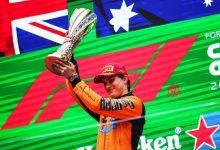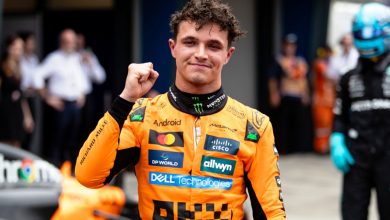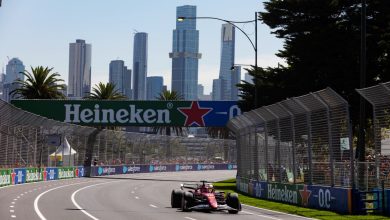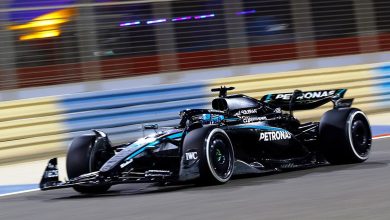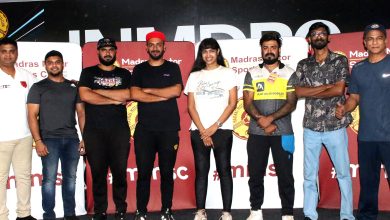Melbourne was excellent but a lot of work to do: Robert Fernely, Sahara Force India
TEAM REPRESENTATIVES – Robert FERNLEY (Force India), Matthew CARTER (Lotus), Paul HEMBERY (Pirelli), Franz TOST (Toro Rosso), Cyril ABITEBOUL (Renault Sport F1), Christian HORNER (Red Bull Racing)
PRESS CONFERENCE
Paul, can I start with you, what did we see today in practice with these extreme temperatures – up to 60 degrees this afternoon – what’s it going to mean for the racing this weekend?
Paul HEMBERY: Well, of course here it depends on what the weather brings along, that’s one of the big variables for everybody. But the hottest conditions we’ve seen for some time, hotter than anything we saw last year. The medium tyre in particular was overheating. About second, eight tenths to a second different maybe between the two compounds. If it was like this on Sunday that would lead us to certainly a three-stop race we think, which would be good after maybe a few too many one-stops in recent times. So it’s tough conditions but we didn’t see any levels of blistering that would have caused any concern. We had a little bit of graining this morning but the track evolves here quite quickly, so relatively straightforward for us.
Well you mentioned one-stops, we saw that in Melbourne last time out. The tyres, apparently, are more consistent but also a little bit, perhaps, more conservative. So without these higher temperatures, like this weekend, is one stop going to be more or less the default for the season or are you hoping to see more stops as we go on.
PH: Well the input has always been two to three in reality and that’s what we’ll be aiming to do. We’re understanding now the evolutions of the cars this year and as we gain more confidence as to where they all are then of course we can make choices that will make sure that we’re closer to the two and three stops rather than the one.
Franz, coming to you, obviously two exciting rookies in your cars this season, both had solid weekends at the opening round in Australia. What are you seeing that these two have got when you look at the data?
Franz TOST: I’ve seen that they are matured to do Formula One. They are very highly skilled and we prepared them quite well during the winter months and in Melbourne and so far they have really done a fantastic job. Also today I must say that both drivers competed quite well and I expect that if we get everything together both of them tomorrow will be within the first ten.
There were some quotes since the last grand prix from Dr Marko of Red Bull about a possible sale of Toro Rosso to Renault. As the team principal of the team what’s your view on that or do you have any comment on that?
FT: I think this would be a fantastic opportunity for Toro Rosso to make the next step forward, because the team wants to be established in the future within the first five in the constructors’ championship and to be part of a manufacturer, to work together with a manufacturer, to be owned by a manufacturer would be exactly this step forward which the team needs to be established in the first five.
Cyril, coming to you then, from a Renault points of view how far along are you in that consideration of acquiring a team like Toro Rosso and how would that fit in with a plan of working with Red Bull?
Cyril ABITEBOUL: I think the first priority is to get the engine right. We’ve seen in Melbourne that it was not really the start of season that we were expecting, both on track and off track, so before starting really to think about doing a car I think we need to get the engine under control, so that’s the priority for the time being. Then if we can do that we’ll have to review the situation from a marketing and strategic perspective and see if there is anything better to do than we are doing currently, from more of Formula One to less of Formula One, but for the time being we are focused on what we are doing.
Now it’s no secret that there have been quite a few quotes from you since the Australian Grand Prix about the problems with Red Bull’s competitiveness not being just about the power unit. Can you elaborate on that?
CA: What I can elaborate is that Melbourne was a big disappointment for the whole team and when I say the whole team it’s Red Bull, Renault and it’s Toro Rosso, so those two guys and myself were all extremely disappointed. I’m sure also extremely frustrated because of the amount of work and the level of expectation for this season when we are all very keen to reduce the gap to Mercedes. Everyone has his own challenge and agenda and we were not where we wanted to be. So I think this has created a lot of frustration and maybe led to some comments that were unjustified on both sides. But I think we need to move on and focus on making progress.
Christian, what’s your view on the points that Cyril has just raised?
Christian HORNER: Well, first of all I think he’s very brave to be sitting there between Toro Rosso and Red Bull. Look, I think that what happened in Melbourne happened. It was a frustrating weekend. We’re all racers at the end of the day; we all want to do the best that we can. Melbourne from start to finish didn’t go in any way to plan. I think that’s what’s encouraging is the way that the two teams have reacted between Melbourne and here and the positive steps that have been made, and we’re experiencing some of those steps on track today. It’s always a difficult situation particularly when you’re race team with an engine supplier and I think that the way the two teams have worked in the time available has been very commendable.
So what’s the best way forward for Red Bull Racing? And what are your thoughts also on what Franz has been saying about Renault’s possible takeover of Toro Rosso?
CH: Well, it sounds like Franz wants to sell his team to Cyril and we then need an engine. We’ve enjoyed a great deal of success with the Renault/Nissan alliance over the last five or six years – 50 grands prix have been won, eight world championships, four drivers’ and four constructors’ – all with Renault power. There are some very capable people within Viry but I think that we’ve seen this year, well not this year, really from last year that Mercedes have set the benchmark at an extremely high level. That’s not their fault, they’ve an incredibly good job and it’s down to the rest of us to work hard to try to catch up and I think the frustration more than anything coming into the first race was that expectations were higher than what we saw in Melbourne and we appear to have taken a retrograde step. But I think having researched properly into those issues, Renault have really started to understand them now and already we’ve seen here a positive step forward.
Robert, a delayed start to testing for you and Force India and the new car, so in light of that how satisfied were you with the points scored in Melbourne in the opening round?
Robert FERNLEY: I think Melbourne for us was an unexpected but very pleasurable finish because the team has worked exceptionally hard over the winter and it’s very nice to be able to go back with points in the first race and a very credible finish. So I think that was excellent but we’ve still got a lot of work to do.
What lies ahead for the rest of the season for Force India, especially as it seems that Toro Rosso, Lotus and Sauber are all stronger this year than last year?
RF: I think what we’ve got to look at is where Force India was at the end of last year and we had a choice to make between staying with our own wind tunnel in Brackley, which is a relatively old tunnel with a 50 per cent model, or restructuring the whole aero department and moving forward. Fortunately for us we’ve got Vijay there to support the team and he made the decision that we would move forward and we’ve restructured the aero. We’re now working exclusively in Cologne with the Toyota wind tunnel, we’ve upgraded the CFD. Unfortunately in that process there’s a slight step backwards and I don’t think we will see really Force India coming to the front again until probably mid-season.
Coming to you Matthew, it certainly looks like Lotus has put 2014 behind it and is getting back to the right level. What has it taken in financial and personnel terms to get here?
Matthew CARTER: I think it’s safe to say that the team had a very difficult 2013 off the track whereas on the track it was very successful. There was some natural loss of personnel and we needed to restructure the team and put it on a more secure footing, which is what we spent most of last year doing. The problems that we had on the track last year certainly didn’t reflect anything that was going on off the track. And then moving into this year, obviously with the change of power unit, with the restructure we have done, a more stable future, as it seems to be for Lotus, then we can hopefully turn that into some points.
And how far can you go? Are you targeting getting on the tail of that Ferrari/Williams battle or…?
MC: Absolutely, yes. We’re looking forward, not looking back. The performance in Melbourne was very strong. Obviously it was unfortunate what happened to both cars in the first lap, but the performance was very strong and yeah, we’re definitely looking forward.
QUESTIONS FROM THE FLOOR
Q: (Pierre van Vliet – F1i.com) A question for Cyril. Is it true you’re your hierarchy at Renault asked you to reply to Red Bull criticism? Otherwise, why be so aggressive publicly?
CA: Well, clearly I don’t think there was a lot of enthusiasm from the corporate offices on the Monday after the race but I don’t think that there is any surprise but obviously the first disappointment will come from engine performance over the weekend. No actually the answer to your question is no, because actually the sequence of events… the quote that you refer to, which again I would like to leave behind, is something that happened over the course of the weekend, so not in reaction to any sort of instruction.
Q: (Luc Domenjoz – Le Matin) It’s also a question for Mr Abiteboul. Since the engine regulation change, your engine seems to be far from being the best and this season seems to be even worse. In any other normal business in the world such a disaster would lead the person in charge to either resign or to be fired. So at Renault did you get your technical director’s resignation or do you consider changing your technical department?
CA: Well, there have been quite a few changes happening actually in the engine structure. First, I would like to comment that I don’t think we are that miles away or doing that bad, let’s see how the season is panning out. Clearly last year was not at the level that we wanted but obviously we were the only one to be capable of winning races [apart from Mercedes]. But answering to your question there have been a lot of changes in Renault Sport F1, which is the unit that is responsible for engine. In particular we have completely restructured back in December, so I was back in that unit in September. December we announced the new organisation, which entered into play in January. We are [in] March and I think it would be a bit of an overreaction trying to change again the structure that we have just operated. Having said that we need to progress, on track but also at the factory, I’m not denying that fact.
Q: (Olav Mol – Sport1 SBS) I have a question for Matthew and for Robert and maybe also for Cyril. After Melbourne we heard Felipe Massa talk about, and answering whether he thought they had the same engine as the Mercedes team, and the answer came “yes of course we have the same engine,” and “yes, everything is the same.” But shouldn’t the question be: ‘do we have the same software?’ So my question to Matthew and Robert is, do you feel you have the same software version as the Mercedes team. And my question to Cyril is: do you deliver to the guys left and right of you, the same software version for the engine you’re using here?
RF: Coming from a Force India point of view, I’ve no complaints at all from Mercedes. They’ve delivered everything we’ve ever wanted. We’ve been with them now for six or seven years and we have absolutely no issues that they are supplying us the same as they are. However, one also has to accept that they are a works team and there are going to be development programmes that come in that will automatically go there first and then trickle down to all the customer teams. So it would be unrealistic to expect it to be the same all the time. But I think primarily where they can, they’re supplying us the same equipment and same software.
Matthew?
MC: Being in the unique situation that we’ve had a contract with both Renault and a contract with Mercedes, I can confirm that we, in the Mercedes contract, it is stipulated that we have complete parity. In the Mercedes contract.
Cyril?
CA: I don’t want to reveal any details of the contract but yes, obviously it is common practice that we chose at Renault. And with the complexity of the new power unit, already managing one is enough, so if you have to manage diversity, honestly it is not something that you want to do.
Q: (Kate Walker – Motorsport.com) Question for everyone except Cyril and Paul really. Christian, when we were talking about cost-cutting over the winter, you did mention the potential of a wind tunnel ban. Now, with limited investment in computing teraflops you can actually get an awful lot more bang for your CFD buck than you can out of wind tunnels. Have you changed your position on banning wind tunnels? And I would like to know how the other three of you feel about that. Thank You.
CH: I think that if we really are serious about addressing costs in Formula One then you’ve got to be able to look at turning it upside down in many respects. One of the holy grails that the teams are reluctant to go near is the wind tunnel. Red Bull has a very strong aerodynamics department. It has a good wind tunnel that we’ve invested a lot of money in over the years – but if you look at the amount of consumption of cash it takes to feed that tunnel, to feed those ideas. If the sport is serious about reducing costs, then we have to look, maybe to say, OK, let’s get rid of wind tunnels, let’s commercially rent them out, as some of the teams already do with their second tunnels, and put in a standard teraflop, or a standard amount of capacity for CFD, and loosen the regulations in certain areas so that you come up with more ingenuity. I think that way you will also come up with different shapes to the cars. Because currently, through the iterative programmes that we all run. If all the cars were painted the same colour, it would be very, very difficult to differentiate between one and the other. I think more technical freedom from a regulatory point of view but constricting the tools that you can do that with, I think would certainly be quite a positive thing for cost-saving in Formula One.
Franz, your thoughts?
FT: Yeah, if you look at the cost aspects. First of all it is the number of people which are working at the teams. If there are 800 people for the chassis and 400 people for the engine, I think it’s far too much. We must come down with the number of employees. Then, of course, we are using very expensive tools. Whether that’s the wind tunnel or CFD, whatever. If we continue working with these tools, then we must reduce the working hours much more than is currently the case. Then the use of standard materials, the use of standard parts, the use of homologated parts and if we really want to come down with the costs then there are always possibilities to do it but the problem currently is that the top teams do not want to come down with the costs because they get anyway the money and they want to spend it. And, I think there we have to first discuss how to go on and how to come down at the end with the costs. The possibilities are more than enough.
Robert?
RF: I completely endorse what Franz and Christian have said. Force India has been an advocate of doing this for at least 18 months, so there’s no question of that. But I think there’s another very important part to it. Apart from what both Franz and Christian said for the existing teams, one of the biggest barriers I think for entry for new teams coming in is the huge cost of wind tunnel programmes. I think it would remove one of those big obstacles to attract new entrants into Formula One. So, I would definitely be for it.
Matthew, your thoughts?
MC: Yeah, it’s no surprise that we at Lotus agree exactly. Exactly with what the other three have said. There is a huge cost to the wind tunnel programme and it makes absolute sense to take it away.
RF: If I could just add one more thing to that. One of the arguments for not getting rid of wind tunnels is that Formula One is the pinnacle of motorsport and should use all of the tools that are available to motor manufacturers and everybody else who use wind tunnels. But if it is the pinnacle of motorsport it should be pushing the boundaries. And the boundaries for us, technically, are in CFD, the same way as we’re pushing the boundaries in hybrid. So, for me, we always have to move the goalposts for Formula One and, taking what is a bit of a dinosaur technology is not one of the options. And I think environmentally it’s sending the wrong message as well. These things are huge consumers of electricity.
Q: (Dieter Rencken – Racing Lines) The two team representatives in the back, Bob Fernley and Matthew Carter, it’s well-known and well-documented that you’ve been approaching the commercial rights holder and pushing him for additional revenues. Do you honestly believe… first of all, could you give us a progress report on your quest please, but also, do you honestly believe that two or three teams could actually be effective against a commercial rights holder like that, in terms of getting more money out of somebody who is notorious for not wanting to pay any more money.
RF: I think the key element is that Bernie, at the end of the day, when things are tough, he understands when they’re tough. He’s shepherded this sport for many, many years, he’s done a great job, and whilst we may have arguments with him along the way, at the end of the day, he’s kept it all together, and I think when he genuinely sees there’s something that’s not quite right, he will address that. We’ve got to go back a little while to
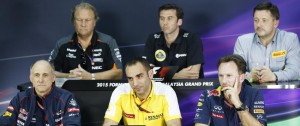
where I think the problems have started, and I think, a few years ago we had FOTA operating in a very good way, it was a consolidated approach, it was well-stewarded by Martin Whitmarsh, we were in joint negotiations with CVC at the time to obviously renegotiate those contracts and everything else. Unfortunately – and I say that because obviously Christian is here – Red Bull felt the need to take the 40 pieces of silver and that was the downside I think for Formula One and I don’t think we’ve recovered from that particular action.
Matthew?
MC: I obviously agree with everything Bob said – but I would add that whilst it’s easy for us to sit here and ask for more money, there is only a certain size of cake – and any more that we ask for has to be taken away from the bigger teams. Now, whilst I understand that they can probably afford to lose some of that money, it’s no question that they’ve built their businesses and structured their businesses on that income which was guaranteed and secured. So it’s not quite as easy as just saying: “you should give more to the smaller teams.” I think it needs to be looked at and that’s why it’s taken such a long time to get to this stage. However, I think that things are starting to move. There seems to be a shift in the tide of opinion within the sport and hopefully it will continue down that route.
Christian, your right of reply to Bob’s comment…
CH: Yeah, I think it’s a little harsh of Bob to suggest that the plight of the smaller teams is all Red Bull’s fault. What you have to remember at the time, FOTA was pretty dysfunctional. It was focussing on the wrong aspects. Ferrari went and cut their own deal, Red Bull weren’t the first team to sign an agreement with Bernie. At the same time, McLaren were also in dual discussions and cut their own deal. That’s the way of the world. We all represent our own entities and y’know, guarantees had to be given by the companies in order to be eligible for that funding. And, y’know, that’s the situation. I can understand the other teams’ frustration but it’s not down to Red Bull to decide what the revenue distribution is – or Ferrari or McLaren. That’s down to Bernie and the board members at CVC. They distribute the money how they see fit.
Q: (Wei An Mao – Titan Media) A question to Matthew. Now we have a Chinese Hong Kong driver in Lotus, Adderly Fong, would you please reveal more the detail about his appointment and is it possible we will see him take part in FP1 in China in two weeks?
MC: I’ll answer the second part first. He won’t be driving in FP1 in China in two weeks. Jolyon Palmer will be driving in FP1 in China. Adderly has been tracked by Gravity Motorsports, who are one of our parent companies and they also run the Lotus junior team, for a number of years. And he’s been highlighted as a potential talent and a potential talent in F1. As a team we are trying to look for young talent, again in terms of trying to make this business work on a business footing, we need to look for young talent, we need to spot young talent at every place that we can. And Adderly’s been highlighted as being a potential F1 star of the future.
Q: (David Croft – Sky Sports) Christian, Red Bull as a brand run many extreme sports around the world, very successfully, and attract a lot of attention. Were Red Bull as a brand in charge of Formula One, and running Formula One, how would you distribute the revenue to ensure that the sport had a healthy future and survived for many years to come and was exciting and loved by all?
CH: Fortunately I run the team but I can see where you’re getting at. I mean, Red Bull don’t run Formula One. Formula One’s run by Bernie and by CVC and, as I say, the distribution of funds, they’ve applied accordingly. Red Bull promotes events, it promotes championships and has done so successfully. Formula One is an expensive business and I think that what we should also be looking at is, what are the cost drivers? What is driving the cost for it to be unsustainable for teams? Even though the distribution isn’t equal, teams like Force India and like Lotus and others actually are receiving more money compared to where they were five years ago by a significant amount – but their problems are still considerable. And I think the problems are there because the regulations, technical and sporting, are driving the costs far too high in the sport. And until we get those under control, we’re all going to have these issues. Big teams are struggling with budgets – not to the same extent – but y’know, there are budget pressures, and I think to get those under control needs a fundamental look at what is Formula One and what does Formula One need to be in the future?
Q: (David Croft – Sky Sports F1) Sorry, can I ask one follow-up question to that please? Is it then the percentage gap between what the big teams earn and what the smaller teams earn that is the root of the problem, not the actual amount but the fact that you’re perceived to be getting way more in a percentage term and are able to spend more and are then forcing other teams to try and keep up with that?
CH: Well no, it’s all relative. What causes or drives your spend are the rules. You look at the rules and you look at the best way to exploit those rules. Ferrari obviously get more money than any of the teams on the grid, irrelevant of where they finish and it doesn’t mean that they’ve been competitive over the last five, six, seven years. Toyota spent more money in the history of Formula One than perhaps any other entrant, didn’t win a Grand Prix, so money doesn’t guarantee success. It enables you to obviously recruit and get the right resource but unless you’ve got the right personnel involved… Formula One is still a people business, it’s still a people sport and you’ve got to have those ingredients in place in order to be successful.
Q: (Haoran Zhou – LETV) Christian, last year at this stage, you were posting some interesting numbers; with two 800 meters straights here, 1.2 kilometer back straight and 800 meter start/finish straight in Shanghai and four long straights in Bahrain, what kind of straightline performance deficit can you project at the moment?
CH: You’ve just depressed me! It’s getting better, so Cyril keeps telling us. It’s been a tough start and – as we’ve said – things happened in Melbourne that… frustration boils over because we’re racers at the end of the day. We want to compete, we’re used to competing and we want to run up at the front and that applies to Red Bull as much as it does to Renault. We’ve got some challenging circuits coming up but Renault have also got some aggressive plans in their pipeline as well, in order to try and reduce that deficit. It’s clear that Ferrari have done a good job over the winter, you can see the step that they’ve made and the target should be exactly the same, to try and replicate that in the tokens and time that we have available.
CA: Indeed, if you look at those numbers it’s not good for the morale but we think that there is light at the end of the tunnel and that the tunnel may not be as long as some people think so let’s keep our heads down, focus. I think that actually with those new technologies there is more than just the absolute power of the engine. We actually see that the crisis which we are going through related to driveability is telling us more than there is just power in those engines and that’s maybe where we need to focus. And the good thing about driveability is that you can change that without using tokens, towards which we are also in a good position because we are the manufacturer who has the most tokens to spend over the season. So let’s see. It’s a people game so if we have the right people, the right structure, I’m sure that we can catch up.
Q: (Kate Walker – Motorsport.com) Paul, we heard this week that you’re undergoing a change of ownership with a new Chinese board. You’ve also said recently that you need to know the changes that are coming in Formula One if you are going to continue as a supplier and as a sponsor because you are uniquely both. Has the change of ownership altered that at all? Is there any indication that the Chinese are interested in continuing in F1 or that they’ve been scared away by the financial messes we find ourselves in at the moment?
PH: The change in ownership… we’ve had many different shareholders, international shareholders over the years so we have a new major shareholder that’s come in. The biggest change will actually be in our industrial truck business where we will be combining both activities to make the most of the synergies in those businesses. Mr Tronchetti will remain for another five years as our CEO. They’ve bought into the management team that we have in Pirelli and an integral part of our vision and our work is also Formula One so from that point of view, no change. Having said that, we have many discussion, we read many discussions where the sport is looking, what it wants to do going forward and of course, if you’re going to go through a tendering process, you would like to understand what those changes are and what the sport’s going to look like, so it’s just a practical thing really. Assuming we get some of that visibility and it looks good and we do hear some good suggestions coming through, if the sport allows the change to happen and that tends to be the biggest issue, people tend to agree to disagree rather than get a commonality of view and that tends to hinder the introduction of a lot of very sensible and a lot of very good ideas. So if that can change and we can actually get the visibility going forward, then we’re very happy with the sport.
Q: (Dieter Rencken – Racing Lines) Christian, you’ve referred on numerous occasions about the guarantees that your parent company had to issue in return for the premiums that are paid. By that, I assume you mean your commitments through to 2020. In which case, how does that square with the comments or possible threats that were made in Melbourne about Red Bull possibly withdrawing from Formula One?
CH: I think you have to – like with all these things – look at the context that that comment was made in. I didn’t make that comment. It was a comment by Helmut and I think that what he was trying to refer to is that should we find ourselves in a situation where we could ultimately find ourselves without an engine supplier should Renault chose to withdraw from Formula One, Mercedes would refuse to supply Red Bull with an engine, it’s unlikely that we would be in a position to take a Ferrari engine so you could find yourself actually forced out of the sport and I think that as with any company, Red Bull again reviews its return on investment: is Formula One delivering for Red Bull as a brand? There are some worrying signs when we see races like we saw in Melbourne but hopefully that’s one chapter in a long story; there’s a long season ahead of us. Red Bull want to compete, Red Bull want to be in Formula One and we want to try and address some of the issues that are currently plaguing the sport that we don’t seem to be able to find any traction with.
Q: (Craig Scarborough – ScarbsF1) Following on from that, we’ve seen Red Bull get deeply involved in the Renault engine programme with engine staff at Milton Keynes, with the talk about the virtual test track at Milton Keynes, obviously bringing in Ilmor involved. How much ownership and pushing have you been involved in the relationship and would that potentially lead to a Red Bull Technology engine, for example?
CH: Well, first of all we have no intention of being an engine manufacturer. We have an amount of resource that we try to supplement and assist Renault where we can. We have a strong simulation group. We have strong facilities and cfd capacity within Red Bull Technology. Basically, what we’re trying to do is work in co-ordination with Renault, to assist the areas where they’re perhaps not so strong and it’s more of a long term view than a short term view but hopefully the strengths that we have in Milton Keynes can be applied to helping Renault engineer themselves out of their current predicament.
CA: I’m not sure that Christian will actually confirm that there is a lot of Red Bull in the engine that was in Melbourne! No, no, seriously, it’s true that we are trying to improve the way that we are working together. I think Christian is absolutely right that we can complement each other very well. There are areas where we have been a little bit complacent in developing where we were extremely successful like in particular simulation and software development and so on and so forth. We have the opportunity to have a better collaboration. The culture is different, the mindset is different, working practice is different, so I think this is basically the change management that we have to drive in order to… and make sure that we align the interest of both parties long term and from a strategy perspective. If we do that, I’m pretty sure that we can be a very successful formula.
Q: (David Croft – Sky Sports F1) Cyril, you’re working together with Red Bull to have a better partnership in the future but how difficult is it to do that when you claim it’s hard to work with a partner who lies and in what areas do you think Adrian Newey has lied to you during your partnership?
CA: I think there has been a bit of a similar question, so I don’t want to say too much of that. Again, that’s one of those things that has a bit also been taken out of context, I guess, just like Helmut’s comments regarding Formula One so let’s leave Melbourne behind us, what goes on tour stays on tour… It’s not what I said. Let’s leave that behind. Let’s look at the progress we have made over these two weeks. Again, Melbourne was extremely frustrating for everyone. I think everyone now has to focus on what’s not performing in the package overall, is not performing in accordance to the expectation. Already this weekend it’s better so let’s be positive, let’s keep morale high and let’s make sure that we continue on that path.
Q: (Dieter Rencken – Racing Lines) To Cyril, Robert and Matthew: Franz has already admitted that there have been some possible talks about a possible purchase of Toro Rosso by Renault but a prudent buyer looks at other options and I believe that Force India and Lotus could also be on the market. Have you looked at them, and also from the back row, your comments… have you had discussions with Renault please?
CA: I can confirm that we are looking at a lot of options, including getting out of Formula One. Honestly, if Formula One is that bad for Renault’s reputation, if we see that we struggle with the current formula, if Formula One is not delivering value what it costs Renault, bearing in mind that when you are an engine supplier you have no financial incentive to develop and to fund engine development, so this is what we are looking at, and obviously we think that we are a credible player in the sport but we want to compete amongst the best brands and that Formula One is good for meet and plan as a brand, then we need to think about what else can we do to what we are doing and if you do that, this is an open market, we have the capacity to have discussions with lots of parties. But as I’ve said, for the time being the focus is on engines.
MC: The first comment is that Lotus isn’t for sale so we’re not looking for a buyer and we’re not for sale. And the second comment is that we’ve just signed a long term deal with Mercedes Benz which takes us through to 2020 so any talk of any change of engine or change of ownership or anything is completely off the cards for Lotus.
RF: Similar really to Matthew. We have a contract with Mercedes until 2020 and I’ve had absolutely no discussions whatsoever with Renault.
eom/FIA transcript of the Friday Press Conference

